The Ebm Guitar Chord, also known as the E flat minor chord, is a fundamental chord for guitarists to learn. While it can’t be played in an open position, mastering the Ebm chord unlocks a wealth of musical possibilities and expands your understanding of minor chords on the guitar. This guide will take you through various ways to play the Ebm chord, delve into its music theory, and explore its uses in different musical contexts.
Understanding the Ebm Chord: Theory Basics
Before diving into shapes, let’s briefly explore the theory behind the Ebm chord. Like all minor chords, the Ebm chord has a characteristically melancholic sound. It is built upon three notes:
- Eb (Root): The foundational note of the chord.
- Gb (Minor Third): This note, a minor third interval above the root, gives the chord its minor quality.
- Bb (Perfect Fifth): The perfect fifth interval above the root, completing the triad.
These notes (Eb, Gb, Bb) are derived from the Eb Major scale, specifically the 1st, flat 3rd, and 5th degrees. Understanding this relationship helps in grasping how chords are constructed within scales and keys.
Just like all minor chords, the Ebm chord contains specific intervals from its root note: a minor third, a major third, and a perfect fourth (returning to the root in the octave). Musically, Ebm is the relative minor of Gb Major, meaning they share the same key signature (six flats). Furthermore, Ebm is the starting chord in the key of Eb minor. The chords within the key of Eb minor are Ebm, F diminished, Gb augmented, Abm, Bb, Cb, and D diminished.
10 Ways to Play the Ebm Chord on Guitar
Here are ten different shapes to play the Ebm chord. Experiment with these to find what sounds best in different musical situations and what feels most comfortable for your playing style.
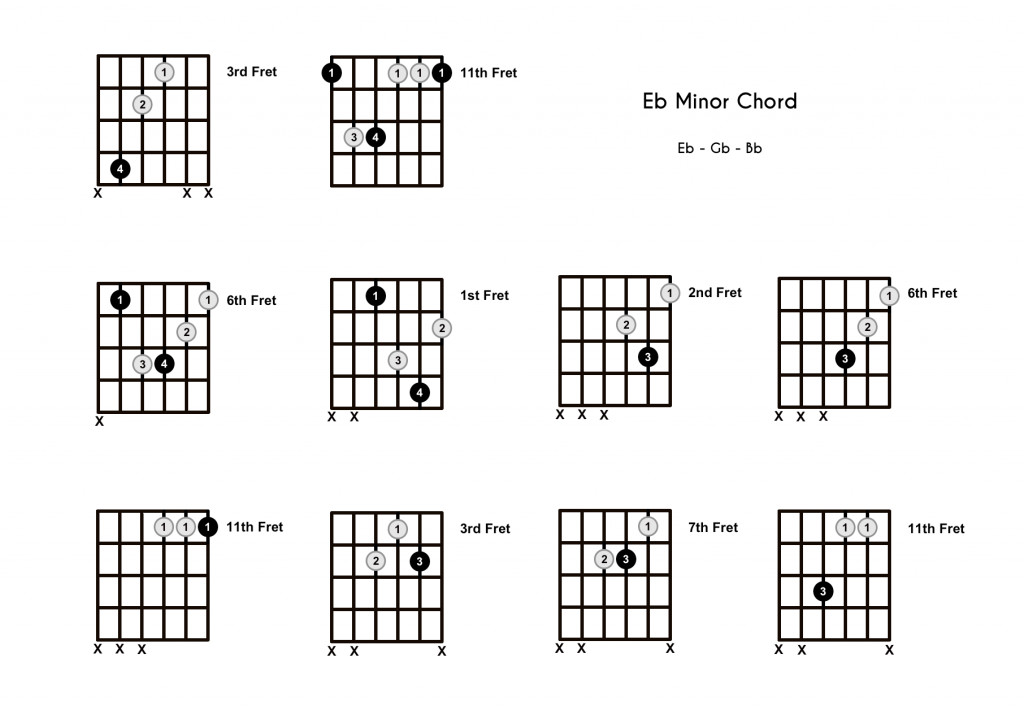 Eb Minor Chord – 10 Shapes
Eb Minor Chord – 10 Shapes
The Standard Ebm Chord Shape: The Root 5 Barre Chord
The most common and versatile way to play the Ebm chord is as a root-5 barre chord. This shape is movable, meaning you can use the same fingering pattern to play other minor chords by simply shifting it up or down the fretboard. For Ebm, you’ll start this shape on the 6th fret.
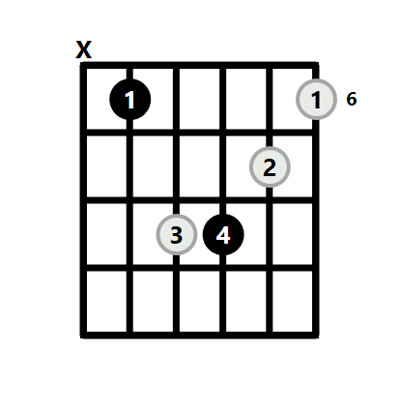 Ebm Chord Guitar
Ebm Chord Guitar
The “Easy” Ebm Chord Shape: A Mini Barre
If you’re new to barre chords or find the full barre shape challenging, the “easy” or “mini” Ebm chord is a great starting point. This simplified version uses only the top three strings and captures the essence of the Ebm chord. It’s played on the 6th, 7th, and 8th frets of the 1st, 2nd, and 3rd strings respectively. Think of it as the top part of the full barre chord.
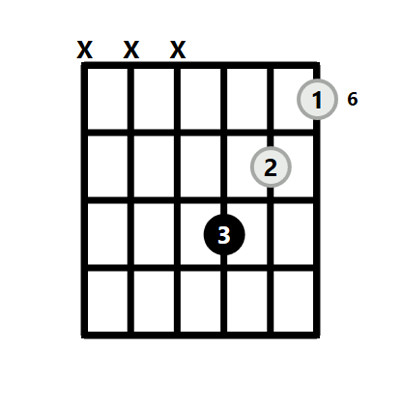 Easy Ebm Chord
Easy Ebm Chord
Step-by-Step Guide to Playing the Standard Ebm Chord
Let’s break down the standard Ebm barre chord shape step-by-step:
- Barre: Place your index finger across all five strings at the 6th fret, pressing down firmly.
- Third Finger: Place your ring finger on the 8th fret of the 4th string.
- Fourth Finger: Place your pinky finger on the 8th fret of the 3rd string.
- Second Finger: Place your middle finger on the 7th fret of the 2nd string.
- Strumming: Strum the first five strings (from the 5th string down to the 1st string). Avoid strumming the 6th string for this particular voicing.
Practicing these steps slowly and methodically will help you form the chord accurately and cleanly.
Exploring Ebm Barre Chord Shapes Further
Beyond the root-5 barre chord, the Ebm chord can also be played using a root-6 barre chord shape. To play the root-6 barre chord version of Ebm, you would use the minor barre chord shape starting on the 11th fret. Both root-5 and root-6 barre chord shapes are essential for any guitarist’s chord vocabulary, offering different voicings and positions on the neck.
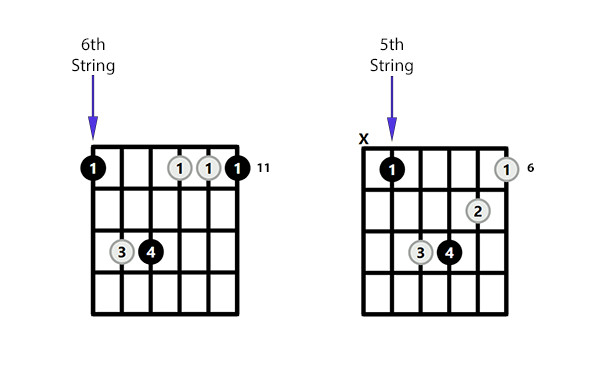 Ebm Barre Chord
Ebm Barre Chord
Ebm Triads: Inversions and Voicings
Delving into triads is a fantastic way to deepen your understanding of the Ebm chord and the guitar fretboard. Triads are three-note chords, and for Ebm, the notes are Eb, Gb, and Bb. By rearranging these notes in different orders (inversions), we create unique voicings and shapes. The three inversions of the Ebm triad are:
- Root Position: Eb – Gb – Bb
- 1st Inversion: Gb – Bb – Eb
- 2nd Inversion: Bb – Eb – Gb
Playing these triads across different string sets allows you to discover six distinct Ebm triad shapes, enriching your playing and arranging possibilities.
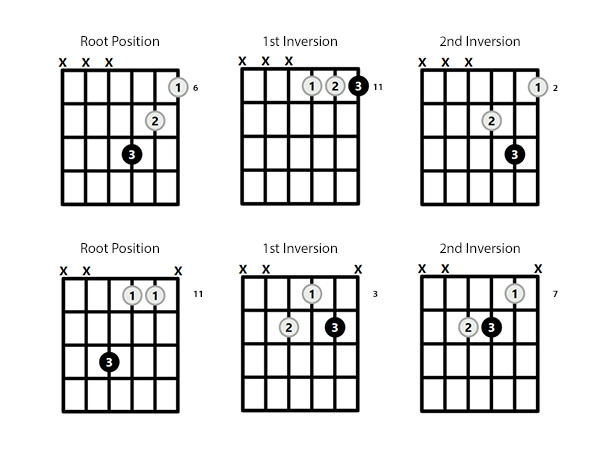 Eb Minor Triad
Eb Minor Triad
Keys That Feature the Ebm Chord
Knowing which keys contain the Ebm chord is crucial for songwriting, improvisation, and understanding chord progressions. The Ebm chord naturally occurs in:
- Eb minor: (Ebm is the tonic chord)
- Ab minor:
- Bb minor:
- Gb Major: (Ebm is the vi chord)
- Db Major: (Ebm is the ii chord)
Understanding these key relationships allows you to effectively use the Ebm chord within various musical contexts and create harmonically interesting progressions.
Alternative and Useful Ebm Chord Shapes
While the standard barre chord and easy shapes are most common, there are alternative Ebm chord shapes that can be useful in specific situations or musical styles. These might offer different voicings or be easier to transition to from surrounding chords in a progression. Exploring these expands your sonic palette and technical versatility.
Substituting the Ebm Chord for Harmonic Variety
To add color and emotion to your music, consider using chord substitutions for the Ebm chord. Chords like Ebm7, Ebm9, Ebm11, and Ebm6 are common substitutes, adding extensions and harmonic complexity.
Furthermore, you can often substitute chords from the relative major key, Gb Major. Variations of the Gb chord, such as Gb6, Gb69, and Gbmaj9, can effectively replace the Ebm chord, creating interesting harmonic shifts and nuances.
Scales to Play Over the Ebm Chord for Soloing and Improvisation
For soloing or writing melodies over the Ebm chord, certain scales work particularly well. Effective scales to use include:
- Eb Minor Pentatonic Scale: A foundational scale for blues and rock improvisation.
- Eb Natural Minor Scale: The parent scale of the Ebm chord, providing a natural minor sound.
- Eb Harmonic Minor Scale: Creates a more dramatic and exotic minor sound due to the raised 7th degree.
- Eb Melodic Minor Scale: Used for melodic phrasing, with different ascending and descending forms.
Experimenting with these scales over an Ebm chord backing track will help you develop your ear and improvisational skills.
Further Exploration
To deepen your understanding of guitar chords and expand your chord vocabulary, consider exploring resources like “Guitar Chords Galore eBook”. Mastering chords like Ebm is a continuous journey, and consistent practice and exploration are key to becoming a well-rounded guitarist.
[
